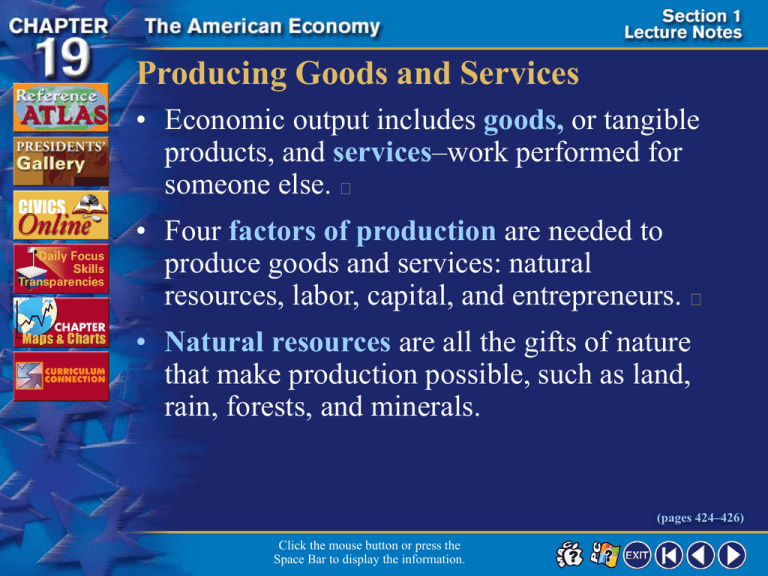Civics Chapter 19
advertisement

Producing Goods and Services • Economic output includes goods, or tangible products, and services–work performed for someone else. • Four factors of production are needed to produce goods and services: natural resources, labor, capital, and entrepreneurs. • Natural resources are all the gifts of nature that make production possible, such as land, rain, forests, and minerals. (pages 424–426) Click the mouse button or press the Space Bar to display the information. Click the mouse button or press the Space Bar to display the answer. Producing Goods and Services (cont.) • Labor is the nation’s workforce or human resources. • It includes the physical and mental talents of the people who help produce goods and services. • Factors such as population growth, education, and war affect the quantity and quality of labor. (pages 424–426) Click the mouse button or press the Space Bar to display the information. Producing Goods and Services (cont.) • Capital, or capital goods, includes the tools, machinery, and buildings used to make other products. • Capital goods are unique because they are themselves produced. • Consumer goods satisfy wants directly; capital goods do so indirectly by aiding production of consumer goods. (pages 424–426) Click the mouse button or press the Space Bar to display the information. Producing Goods and Services (cont.) • Entrepreneurs are individuals who start new businesses, introduce new products, and improve management techniques. • They are innovative and willing to take risks. • They drive the economy because they use factors of production to produce new products. (pages 424–426) Click the mouse button or press the Space Bar to display the information. Producing Goods and Services (cont.) How are capital goods different from consumer goods? Consumer goods are things like clothes, clocks, shoes, and foods that satisfy wants directly. Capital goods satisfy wants indirectly. They are the tools, machinery, and buildings used to produce consumer goods. (pages 424–426) Click the mouse button or press the Space Bar to display the answer. Gross Domestic Product • Gross Domestic Product (GDP) is a measure of the size of the economy. • It is the total value, in dollars, of all final goods and services produced in the country during a single year. • Final goods are goods sold to their users. (pages 426–427) Click the mouse button or press the Space Bar to display the information. Gross Domestic Product (cont.) • GDP does not count intermediate goods, which are components of final goods. • It also does not count the sale of used goods, which do not represent new production. • GDP is expressed in terms of money. • This enables us to compare the relative worth of goods and services, which is more meaningful than simply numbers of products. (pages 426–427) Click the mouse button or press the Space Bar to display the information. Gross Domestic Product (cont.) • To compute GDP, identify all goods and services produced and their average prices. • Multiply the number produced of each item by its average price. • Then add up everything. (pages 426–427) Click the mouse button or press the Space Bar to display the information. Gross Domestic Product (cont.) • If the new GDP is higher than the previous one, then the economy is expanding. • If it is lower, the economy is declining. • Economists study GDP figures regularly to analyze business cycle patterns. (pages 426–427) Click the mouse button or press the Space Bar to display the information. Gross Domestic Product (cont.) • Standard of living is the quality of life based on the possession of necessities and luxuries that make life easier. • When GDP grows faster than the population, there are more goods and services, on average, for us to enjoy. • GDP does not measure society’s overall wellbeing!!! • Other things–such as a reduction in crime and drug abuse and greater equality of opportunity–can make a country better off without raising GDP. (pages 426–427) Click the mouse button or press the Space Bar to display the information. Gross Domestic Product (cont.) • Failure to account for improvements in product quality is a shortcoming of GDP. • Greater production of goods and services is only one of many factors that raise the standard of living. (pages 426–427) Click the mouse button or press the Space Bar to display the information. Gross Domestic Product (cont.) What are some limitations of GDP as a measurement? GDP does not measure society’s overall well-being. Many things could make a country better off without necessarily raising GDP, such as a reduction of crime, greater equality of opportunity, and reduction of drug and alcohol abuse. Also, GDP does not reflect improvements in quality of products. GDP is only one of many factors that contribute to raising the standard of living. (pages 426–427) Click the mouse button or press the Space Bar to display the answer. Checking for Understanding Define Match the terms on the right with their definitions on the left. __ A 1. tangible product that we use to satisfy our wants and needs A. good __ D 2. individuals who start new businesses, introduce new products, and improve management techniques C. factors of production B 3. __ work performed by a person for someone else E 4. __ total dollar value of all final goods and services produced in a country during a single year C 5. __ resources necessary to produce goods and services Click the mouse button or press the Space Bar to display the answers. B. service D. entrepreneurs E. Gross Domestic Product (GDP) Checking for Understanding (cont.) Explain What are the major functions of the entrepreneur? The major functions of an entrepreneur are to start new businesses and bring products to market. Click the mouse button or press the Space Bar to display the answer. Critical Thinking Making Comparisons Is a pizza oven a capital good or a consumer good? Explain. A pizza oven is a capital good because it produces a consumer good, namely pizza. Click the mouse button or press the Space Bar to display the answer. Circular Flow of Economic Activity • A market is a location or other situation that allows buyers and sellers to exchange a certain economic product. • Markets can be local, regional, national, or global. (pages 428–430) Click the mouse button or press the Space Bar to display the information. Circular Flow of Economic Activity (cont.) • The economic decision makers are the consumer, business, government, and foreign sectors. • A circular flow of economic activity– resources, goods and services, and money– takes place among these groups. (pages 428–430) Click the mouse button or press the Space Bar to display the information. Circular Flow of Economic Activity (cont.) • Consumers earn their income in factor markets, where productive resources are bought and sold. • Workers sell their labor for income. • People who own land loan it in return for rent. • People who own capital exchange it for interest. (pages 428–430) Click the mouse button or press the Space Bar to display the information. Circular Flow of Economic Activity • People spend their income in product markets, where producers offer goods and services for sale. (cont.) • Businesses receive payments for their products from consumers. • They spend this income on natural resources, labor, and capital to make more products. • The business sector buys capital goods in the product markets to use in production. (pages 428–430) Click the mouse button or press the Space Bar to display the information. Circular Flow of Economic Activity (cont.) • The government sector buys productive inputs in the factor markets to use in creating its goods and services. • While government receives some revenue from selling its services, most of its revenue comes from taxes. • It also uses its revenue to buy final goods and services in the product markets. • The foreign sector includes all the countries in the world. • The United States buys from and sells to other countries. (pages 428–430) Click the mouse button or press the Space Bar to display the information. Circular Flow of Economic Activity (cont.) What kinds of products does the business sector buy in product markets? Why? The business sector purchases primarily capital goods for use in producing more goods and services. These purchases include things such as tools, equipment, and factories. (pages 428–430) Click the mouse button or press the Space Bar to display the answer. Productivity and Economic Growth • When a nation’s total output increases over time, the economy grows. • This means the circular flow becomes larger. (pages 430–432) Click the mouse button or press the Space Bar to display the information. Productivity and Economic Growth (cont.) • Productivity is a measure of the amount of output produced by a given amount of inputs in a specific period of time. • It reflects how efficiently resources are being used. (pages 430–432) Click the mouse button or press the Space Bar to display the information. Productivity and Economic Growth • Specialization can improve productivity. (cont.) • People, businesses, and countries concentrate on the goods or services they can produce better than anyone else. • We specialize because we earn more by doing the things we do well. • It is also more efficient to specialize than to do everything for ourselves. (pages 430–432) Click the mouse button or press the Space Bar to display the information. Productivity and Economic Growth • Division of labor is the breaking down of a job into separate, smaller tasks performed by different workers. (cont.) • It is a form of specialization, making use of differences in skills. (pages 430–432) Click the mouse button or press the Space Bar to display the information. Productivity and Economic Growth • Human capital is the sum of all the skills, abilities, and motivation of people. (cont.) • When businesses invest in things like training and employee health care, worker productivity tends to increase. (pages 430–432) Click the mouse button or press the Space Bar to display the information. Productivity and Economic Growth (cont.) • Because of specialization, the American economy displays a high degree of economic interdependence. • We rely on others, and others rely on us, to provide the goods and services we consume. • As a result, events in one part of the world can have an economic impact on other parts of the world. (pages 430–432) Click the mouse button or press the Space Bar to display the information. Productivity and Economic Growth (cont.) When does productivity go up? Productivity goes up whenever more output can be produced with the same amount of inputs in the same amount of time. It also goes up when the same output can be produced with less input. (pages 430–432) Click the mouse button or press the Space Bar to display the answer. Checking for Understanding Define Match the terms on the right with their definitions on the left. __ E 1. __ D 2. __ C 3. a market where productive resources are A. productivity bought and sold B. specialization a market where producers offer goods C. division of labor and services for sale D. product market the breaking down of a job into separate, E. factor market smaller tasks to be performed individually __ A 4. the degree to which resources are being used efficiently to produce goods and services __ B 5. when people, businesses, regions, and/or nations concentrate on goods and services that they can produce better than anyone else Click the mouse button or press the Space Bar to display the answers. Checking for Understanding (cont.) Identify Do consumers earn their income in the product market or the factor market? Consumers earn their income in the factor market. Click the mouse button or press the Space Bar to display the answer. Features of Capitalism • The U.S. economy is built on capitalism and free enterprise. • Capitalism is an economic system in which private citizens own and use the factors of production to seek a profit. • Free enterprise is an economy in which competition is allowed to flourish with a minimum of government interference. (pages 434–436) Click the mouse button or press the Space Bar to display the information. Features of Capitalism (cont.) • Markets are places where different sectors of the economy interact, and their exchanges determine the prices of goods and services. • Businesses try to produce the products people want most. • Because of this, we use the term consumer sovereignty to describe the consumer as ruler of the market, the one who determines what products will be produced. (pages 434–436) Click the mouse button or press the Space Bar to display the information. Features of Capitalism (cont.) • Choice is a key element for free enterprise. • We are free to choose the occupation we want and where we want to work. • We can choose the products we will buy. • Businesses can choose the products they will produce and offer for sale. (pages 434–436) Click the mouse button or press the Space Bar to display the information. Features of Capitalism (cont.) • Along with the freedom to choose comes the responsibility to accept the consequences of the decisions. • If an entrepreneur starts a business that fails, the government usually won’t help out. (pages 434–436) Click the mouse button or press the Space Bar to display the information. Features of Capitalism (cont.) • Under capitalism, we also have private property rights. • We are free to own and use, or dispose of, our own property as we choose as long as we do not interfere with the rights of others. • These rights give us the incentive to work, save, and invest. (pages 434–436) Click the mouse button or press the Space Bar to display the information. Features of Capitalism (cont.) • Capitalism thrives on competition–the struggle between buyers and sellers to get the best products at the lowest prices. • Competition between sellers tends to reduce production costs and increase product quality. (pages 434–436) Click the mouse button or press the Space Bar to display the information. Features of Capitalism (cont.) • Competition rewards the most efficient producers and forces the least efficient out of business. • Competition results in efficient production, higher-quality products, and more satisfied customers. (pages 434–436) Click the mouse button or press the Space Bar to display the information. Features of Capitalism (cont.) • Profit is the money left over after all costs of production have been paid. • The profit motive is the driving force behind free enterprise and capitalism. • People are willing to invest in a business venture and risk losing their investment for the chance to earn a profit. (pages 434–436) Click the mouse button or press the Space Bar to display the information. Features of Capitalism (cont.) • Voluntary exchange is the act of buyers and sellers freely and willingly engaging in market transactions. • As long as exchanges are voluntary, both buyer and seller must feel that they benefit from their exchange, or they will not do it. (pages 434–436) Click the mouse button or press the Space Bar to display the information. Features of Capitalism (cont.) In what way does the profit motive involve risk? Under free enterprise and capitalism, people are free to risk their wealth in a business venture. If the venture goes well, the people will earn a profit reward. If things go poorly, they could lose part or all of their investment. The chance of loss is the risk investors take in hopes of earning a profit. (pages 434–436) Click the mouse button or press the Space Bar to display the answer. The Spread of Capitalism • Capitalism developed gradually over hundreds of years. • Two concepts underlie the market system: people can work for economic gain and government should have a very limited role in the economy. (pages 436–437) Click the mouse button or press the Space Bar to display the information. The Spread of Capitalism (cont.) • Trade routes opened between Europe and the East in the 1200s. • As trade increased, people began to invest money to make profits. • By the 1700s, Europe had a new attitude about work and wealth. • It included the ideas of progress, invention, and free markets in which buyers and sellers could make unlimited economic decisions. (pages 436–437) Click the mouse button or press the Space Bar to display the information. The Spread of Capitalism (cont.) • In his book The Wealth of Nations, Scottish economist Adam Smith scientifically described the basic principles of economics for the first time. • Smith believed that individuals, in seeking profit, end up benefiting society as a whole. (pages 436–437) Click the mouse button or press the Space Bar to display the information. The Spread of Capitalism (cont.) • From the writings of Smith and others came the idea of laissez-faire, meaning “to let alone.” • According to this philosophy, government should not interfere in the marketplace. • Government’s role is to ensure free competition. • Many American Founders were influenced by Smith’s book. (pages 436–437) Click the mouse button or press the Space Bar to display the information. The Spread of Capitalism (cont.) • Communism and capitalism have been viewed as opposing political and economic structures. • The collapse of communism, however, did not mean a smooth transition to capitalism. (pages 436–437) Click the mouse button or press the Space Bar to display the information. The Spread of Capitalism (cont.) In laissez-faire economics, what is the role of government? The government’s role is strictly limited to those few actions needed to ensure free competition in the marketplace. (pages 436–437) Click the mouse button or press the Space Bar to display the answer. Checking for Understanding Define Match the terms on the right with their definitions on the left. __ A 1. __ E 2. __ B 3. __ C 4. __ D 5. the role of consumer as the ruler of the market, determining what products will be produced the act of buyers and sellers freely and willingly engaging in market transactions the freedom to own and use our own property as we choose as long as we do not interfere with the rights of others the struggle that goes on between buyers and sellers to get the best products at the lowest prices the money a business receives for its products or services over and above its costs Click the mouse button or press the Space Bar to display the answers. A. consumer sovereignty B. private property rights C. competition D. profit E. voluntary exchange Checking for Understanding (cont.) Explain What are the limits of private property rights? People have the freedom to use their property as they choose as long as they do not interfere with the rights of others. Click the mouse button or press the Space Bar to display the answer. Close Do you think “modified free enterprise” is an appropriate description of the American economic system? Consumer Rights and Responsibilities • Consumers have rights and responsibilities in our free enterprise system. • Consumerism is a movement to educate buyers about the purchases they make and to demand better and safer products from manufacturers. (pages 438–440) Click the mouse button or press the Space Bar to display the information. Consumer Rights and Responsibilities (cont.) • Many laws protect consumer rights. • The Fair Packaging and Labeling Act requires every package to have a label identifying its contents and how much it weighs. • The Pure Food and Drug Act requires manufacturers of foods, cosmetics, and drugs to prove their products are safe. (pages 438–440) Click the mouse button or press the Space Bar to display the information. Consumer Rights and Responsibilities (cont.) • The Better Business Bureau is one of many groups formed to protect consumers. • Businesspeople run the local bureaus. • They provide information about local businesses, warn of dishonest practices, and investigate consumer complaints. (pages 438–440) Click the mouse button or press the Space Bar to display the information. Consumer Rights and Responsibilities (cont.) • President John F. Kennedy, and later President Richard Nixon, emphasized five rights known as the Consumer Bill of Rights. • Consumers have the right to a safe product, to be informed, to choose, to be heard, and to redress. (pages 438–440) Click the mouse button or press the Space Bar to display the information. Consumer Rights and Responsibilities (cont.) • With consumer rights come responsibilities. • If a product or service is faulty, you are responsible for starting the problem-solving process. • State the problem and suggest a fair solution. • Keep an accurate record of your efforts to solve the problem. • If necessary, contact the manufacturer in writing and keep a copy. (pages 438–440) Click the mouse button or press the Space Bar to display the information. Consumer Rights and Responsibilities (cont.) • A warranty is a promise made by a manufacturer or seller to repair or replace a product within a certain time if it is faulty. • Consumers are also responsible for exhibiting ethical behavior by respecting the rights of producers and sellers. (pages 438–440) Click the mouse button or press the Space Bar to display the information. Your Role as a Consumer • Disposable income is money a person has left after all the taxes on it have been paid. • People generally use it first to buy necessities, such as food and housing. • Discretionary income is money left over after paying for necessities that can be used for satisfying wants, including luxury items and savings accounts. (pages 440–442) Click the mouse button or press the Space Bar to display the information. Your Role as a Consumer (cont.) • Virtually all the steps in the consumer decision-making process involve an opportunity cost. • Consumers must decide if a purchase is worth the next best option they would have to give up. • Consider your goals when you make a buying decision. • Buying things now will make long-term financial goals harder to accomplish. (pages 440–442) Click the mouse button or press the Space Bar to display the information. Your Role as a Consumer (cont.) • Saving is setting aside income for use later. • It is the part of your income that you don’t spend. • Saving enables people to make major purchases, such as a car or a house. • Saving also comes in handy in emergencies. (pages 440–442) Click the mouse button or press the Space Bar to display the information. Your Role as a Consumer (cont.) • Saving by individuals benefits the economy as a whole. • Saving provides money for others to invest or spend. • Saving also allows businesses to expand. • Saving provides money for others to invest or spend. • Saving also allows businesses to expand. (pages 440–442) Click the mouse button or press the Space Bar to display the information. Your Role as a Consumer (cont.) • To save regularly, workers can have their employers withhold a fixed amount from their paychecks and deposit it automatically into their savings accounts. • Or, people may do it themselves by saving a specific amount each week or month. (pages 440–442) Click the mouse button or press the Space Bar to display the information. Your Role as a Consumer (cont.) • Interest is the payment people receive when they lend money, or allow someone else to use their money. • Money saved in a bank earns interest at periodic intervals for as long as funds are in the account. • Saving is a trade-off. • You decide to spend less today to increase your ability to spend in the future. (pages 440–442) Click the mouse button or press the Space Bar to display the information. Your Role as a Consumer (cont.) • To decide how much to save, you need a plan. • Your plan would consider your everyday expenses, reasons for saving, interest you could earn, and your potential to earn a higher income in the future. (pages 440–442) Click the mouse button or press the Space Bar to display the information. Your Role as a Consumer (cont.) How does saving by individuals benefit the economy as a whole? Saving provides money for others to invest or spend. Saving also allows businesses to expand, which provides increased income for consumers and raises the standard of living. (pages 440–442) Click the mouse button or press the Space Bar to display the answer. Checking for Understanding Define Match the terms on the right with their definitions on the left. __ C 1. __ D 2. __ B 3. __ A 4. __ E 5. the responsibility of consumers to respect the rights of producers and sellers money income left after all taxes on it have been paid the promise made by a manufacturer or a seller to repair or replace a product within a certain time period if it is faulty a movement to educate buyers about the purchases they make and to demand better and safer products from manufacturers money income left after necessities have been bought and paid for Click the mouse button or press the Space Bar to display the answer. A. B. C. D. consumerism warranty ethical behavior disposable income E. discretionary income Critical Thinking Making Generalizations Why do some people buy brand-name products and other people buy generic products? Possible answer: Some people purchase brand names because they ensure consistent quality, while other people purchase generic products because they offer savings. Click the mouse button or press the Space Bar to display the answer. Section 1: Economic Resources • The four factors of production are natural resources, labor, capital, and entrepreneurs. • The factors of production provide the means for a society to produce its goods and services. Click the mouse button or press the Space Bar to display the information. Section 2: Economic Activity and Productivity • Productivity related to the efficient use of resources. • Productivity tends to go up when workers specialize in the things they do best. Click the mouse button or press the Space Bar to display the information. Section 3: Capitalism and Free Enterprise • The economic system of the United States is based on capitalism and free enterprise. • Important characteristics are markets, economic freedom, competition, private property rights, the profit motive, and voluntary exchange. Click the mouse button or press the Space Bar to display the information. Section 4: The Economy and You • Consumer advocates promote the following consumer rights: the right to safety, to be informed, to choose, to be heard, and to redress. Click the mouse button to return to the Contents slide. Reviewing Key Terms Define Match the terms on the right with their definitions on the left. __ C 1. __ E 2. natural resources, labor, capital, and entrepreneurs used to produce goods and services the amount of goods and services produced from a given level of inputs A. voluntary exchange B. specialization C. factors of production D. consumer sovereignty E. productivity __ A 3. a transaction in which a buyer and seller work out their own terms of exchange __ D 4. role of consumer as ruler of the market when determining goods and services produced __ B 5. the use of resources by an individual, a firm, a region, or a nation to produce one or a few goods and services Click the mouse button or press the Space Bar to display the answers. Reviewing Main Ideas What factors of production are required to produce the things that people use? The factors of production are land, labor, capital, and entrepreneurs. Click the mouse button or press the Space Bar to display the answer. Reviewing Main Ideas (cont.) What is the difference between a final good and an intermediate good? A final good is sold to its user. An intermediate good is used to produce a final good. Click the mouse button or press the Space Bar to display the answer. Reviewing Main Ideas (cont.) What does the idea of consumer sovereignty express? The idea of consumer sovereignty is that consumers determine what products are produced. Click the mouse button or press the Space Bar to display the answer. Reviewing Main Ideas (cont.) What is the drive to improve your material wellbeing called? The drive to improve your material well-being is called the profit motive. Click the mouse button or press the Space Bar to display the answer. Reviewing Main Ideas (cont.) What is a warranty? A warranty is the promise by a seller or manufacturer to repair or replace a defective product. Click the mouse button or press the Space Bar to display the answer. Critical Thinking Categorizing Information Describe how either you or a relative of yours who has a job fits into the circular flow model. Be sure to discuss both the factor and product markets. Labor supplied in the factor market allows people to buy goods and services in the product market. Click the mouse button or press the Space Bar to display the answer. Analyzing Visuals Study the chart on page 426 of your textbook. What does the figure show? What two categories of economic products are shown? The figure shows computing Gross Domestic Product. The two categories shown are goods and services. Click the mouse button or press the Space Bar to display the answer. Directions: Choose the best answer to the following question. Which of the following statements about Gross Domestic Product is NOT true? A It includes intermediate goods. B It includes services as well as goods. C It is based on dollar value. D It includes final goods. Test-Taking Tip Read the question carefully. When a question uses the word not or except, you need to look for the answer that does not fit. Click the mouse button or press the Space Bar to display the answer. Which factor of production do you consider most important? Explain your answer. Possible answer: Entrepreneurs are most important because they bring the other factors of production together to produce benefits for society. Click the mouse button or press the Space Bar to display the answer. Click the mouse button to return to the Contents slide. Explore online information about the topics introduced in this chapter. Click on the Connect button to launch your browser and go to the Civics Today: Citizenship, Economics, & You Web site. At this site, you will find interactive activities, current events information, and Web sites correlated with the chapters and units in the textbook. When you finish exploring, exit the browser program to return to this presentation. If you experience difficulty connecting to the Web site, manually launch your Web browser and go to http://civ.glencoe.com Charts Computing GDP The Circular Flow of Economic Activity Click on a hyperlink to view the corresponding slides. Click the mouse button or press the Space Bar to display the answer. Click the mouse button or press the Space Bar to display the answer. Click the mouse button or press the Space Bar to display the answer.







